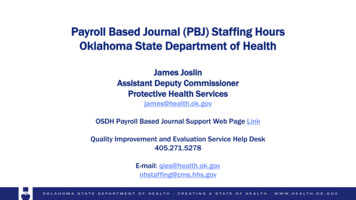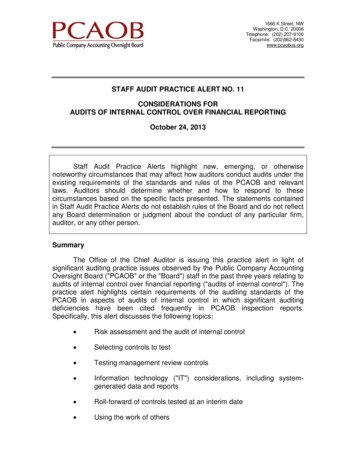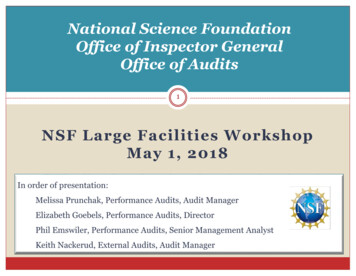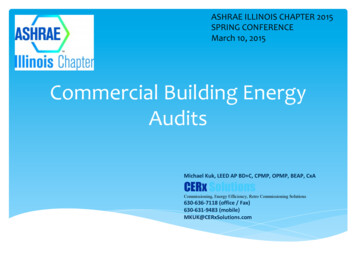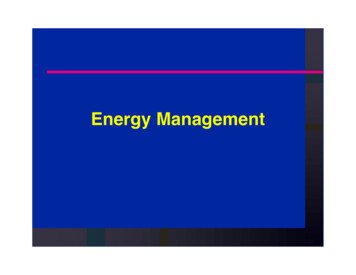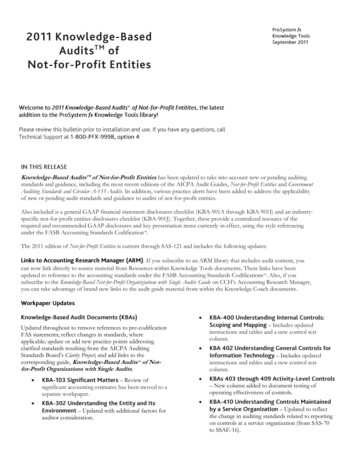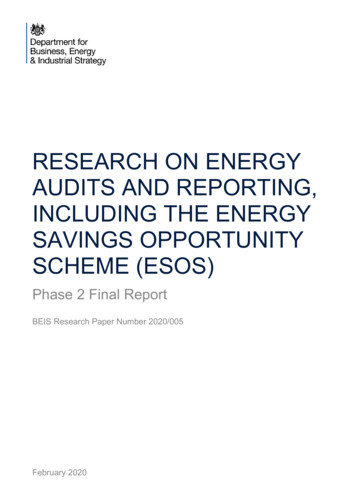
Transcription
RESEARCH ON ENERGYAUDITS AND REPORTING,INCLUDING THE ENERGYSAVINGS OPPORTUNITYSCHEME (ESOS)Phase 2 Final ReportBEIS Research Paper Number 2020/005February 2020
Crown copyright 2020This publication is licensed under the terms of the Open Government Licence v3.0 except where otherwise stated.To view this licence, visit e/version/3 or write to theInformation Policy Team, The National Archives, Kew, London TW9 4DU, or email:psi@nationalarchives.gsi.gov.uk.Where we have identified any third-party copyright information you will need to obtain permission from thecopyright holders concerned.Any enquiries regarding this publication should be sent to us at:enquiries@beis.gov.uk2
Research on energy audits and reporting, including the Energy Savings Opportunity Scheme (ESOS)ContentsContents 3Glossary 5Executive Summary 6Key findings 6Background, objectives and methodology 7Summary of main findings 91. Introduction and background 12Background to this research 12Aims and objectives of this research 14Methodology 15Limitations to the evaluation 17Interpreting quantitative findings 192. Influence and Impact of ESOS on organisations 202.1 Organisational uptake of energy efficiency measures 212.2 Organisational uptake of fuel efficiency measures 282.3 Impact of ESOS on organisational costs of doing business 323. Wider organisational impacts of ESOS 343.1 Influence of ESOS on broader culture around energy efficiency within organisations 343.2 Further outcomes related to ESOS compliance 414. Contexts and mechanisms that facilitate implementation of energy and fuel efficiencymeasures 454.1 Organisational contexts leading to implementation of energy efficiency actions 464.2 Mechanisms within audits that drive organisational action on energy efficiency 504.3 Other factors beyond ESOS driving action on energy efficiency 535. Influence and impact of ESOS on the wider market for energy efficiency services andproducts 565.1 Influence and Impacts of ESOS on the Assessor Market 565.2 Influence and Impacts of ESOS on the energy efficiency supply chain 626. Appetite for audits and reporting across non-domestic sector 656.1 Uptake of audits outside ESOS 656.2 Reporting 687. Lessons Learned: supporting better organisational energy management 707.1 Lessons learned from implementing ESOS: smoothing demand for audit activity 717.2 Lessons learned for maximising organisational engagement in, and value from, audits 723
Research on energy audits and reporting, including the Energy Savings Opportunity Scheme (ESOS)7.3 Additional support and levers that can help drive better energy management in nondomestic organisations 75Annex A: Summary of evidence against Research Questions 774
Research on energy audits and reporting, including the Energy Savings Opportunity Scheme (ESOS)GlossaryCCA – Climate Change AgreementCCL – Climate Change LevyCRC - CRC Energy Efficiency Scheme (formerly known as the “Carbon ReductionCommitment”)DEC – Display Energy CertificateEED – EU Energy Efficiency DirectiveEPC – Energy Performance CertificateESOS – Energy Savings Opportunity SchemeEU ETS – EU Emissions Trading SystemROI – Return on InvestmentSECR – Streamlined Energy and Carbon ReportingSME – Small and Medium-sized Enterprises5
Research on energy audits and reporting, including the Energy Savings Opportunity Scheme (ESOS)Executive SummaryKey findingsThis evaluation has found that:-38% of all energy efficiency measures implemented or planned by organisations sincestarting the ESOS process were attributed at least in part to the scheme. ESOS wasmost commonly associated with encouraging improvements to lighting or processrelated measures.-32% of all the fuel efficiency measures that had been implemented or planned byorganisations since ESOS were attributed at least in part to the scheme.-The energy and fuel efficiency improvements were modelled to have resulted incentral estimates of 1.65TWh of energy efficiency savings from buildings, 1.51TWhsavings for industrial processes, and 0.52TWh of fuel efficiency savings across theESOS population.-As a new mandatory requirement, ESOS often encouraged audit activity inorganisations for the first time. For some organisations, ESOS was attributed withencouraging collation and discussion of data across the business and increasingawareness of energy or fuel consumption and cost.-Case study visits to organisations showed that in some cases, ESOS identifiedentirely new energy saving opportunities. While this was not universal, in other casesthe audit remained valuable where it provided external validation of measures thatwere already planned.-37% of organisations agreed that ‘changes made as a result of ESOS had already ledto net cost savings’ for their organisation by the time of the survey. A number oforganisations also reported some wider benefits such as increased staff productivityand reputational benefits.-The scope for ESOS to have impact is more limited in organisations with existing highlevels of energy maturity, such that ESOS-driven action was lower where prior energymanagement certification, goals or plans were already in place.-ESOS compliance generated significant volumes of work for the assessor marketaround the December 2015 compliance deadline, but there was limited evidence of itsinfluence driving the development of a stable market in the longer-term.-Based on the evidence collected in this study it is suggested that additional supportand levers may help organisations to go further in implementing energy efficiencymeasures. These could include sharing of best practice and publication ofbenchmarks, public reporting of recommended measures, promoting or incentivisingISO 50001 certification, and maximising synergies with other policies, such asStreamlined Energy and Carbon Reporting (SECR).6
Research on energy audits and reporting, including the Energy Savings Opportunity Scheme (ESOS)Background, objectives and methodologyBackgroundThis research was commissioned by BEIS to inform how best to promote greater energyefficiency in buildings and industry and so support an objective to minimise business energycosts by converting cost-effective energy efficiency potential.Article 8 (4-6) of the EU Energy Efficiency Directive (EED) required all member states toestablish an energy audits regime for large enterprises. Energy audits involve the variousactivities and processes that make up an organisation’s energy consumption being audited bya trained assessor, who then makes tailored energy savings recommendations based on theaudit.In the UK the Energy Savings Opportunity Scheme (ESOS) was introduced in 2014 toimplement Article 8 (4-6) of the Directive. Under ESOS, energy audits are mandatory for alllarge undertakings 1 in the UK. Equivalent schemes have also been implemented in all otherMember States 2.This research has considered the effectiveness of energy audits across the non-domesticsector, predominantly focusing on businesses. An evaluation of ESOS is central to theresearch, with ESOS being the key policy mechanism driving uptake of audits in the UK bymandating this activity among non-SMEs (small and medium-sized enterprises). However, thewider role of audits across the non-domestic sector has also been explored.The research also considers the effectiveness of energy reporting, another mechanism thatcan be used to encourage energy efficiency action in non-domestic organisations. Energyreporting can take the form of internal reporting of energy use from one part of an organisationto another, or public external reporting in annual reports and/or directly to government.The findings in this report build further on an interim process and early impact evaluation ofESOS carried out from 2015 to 2017 by Ipsos MORI and University College London (UCL).Large undertakings refer to those with at least 250 employees, or both a turnover in excess of 50m and abalance sheet total greater than 43m, i.e. non-SMEs according to the EC definition2 The Directive requires all qualifying undertakings to carry out an audit of their energy consumption and identifyenergy saving opportunities by December 2015, and every four years thereafter.17
Research on energy audits and reporting, including the Energy Savings Opportunity Scheme (ESOS)ObjectivesFour key research questions about energy audits and reporting, and ESOS in particular, havebeen addressed through this study:RQ1: Energy audits and reporting: To what extent (in which ways and in which contexts) areenergy audits and reporting effective in identifying and delivering energy efficiency savingsacross organisations?RQ2: ESOS influence and impact: To what extent (in which ways and in which contexts) hasESOS influenced organisational energy efficiency policy and practice? What impact has ESOShad on energy efficiency in organisations?RQ3: ESOS lessons for future policy: What are the lessons learned from implementingESOS that could feed into future policies?RQ4: Wider learning: What is the wider learning from this research for BEIS policy making?MethodologyThis study involved the following workstrands, delivered across two main phases of activity:Phase 1 consisted of: A literature review of the implementation of Article 8 (4-6) of the EED in other EUmember states, of energy efficiency schemes based on energy audits in non-EUcountries, and of success factors for audits delivered in other sectors; Stakeholder workshops and interviews with ESOS-obligated organisations, SMEs,public sector organisations and trade bodies to understand appetite for, andexperiences of, energy audits and reporting across the UK non-domestic sector(including but not limited to ESOS).The detailed findings of Phase 1 are reported separately 3, although are summarised within thisreport as relevant.This report primarily focuses on Phase 2 which consisted of: A quantitative telephone survey of 503 compliers from the first phase of ESOS,including 282 that took part in a baseline survey in 2016; 10 qualitative organisational case studies with ESOS organisations (8) and SMEs (2);involving multiple interviews across the organisations to gather a range of perspectives; 20 in-depth interviews with ESOS Lead Assessors; 13 in-depth interviews with representatives of the energy efficiency supply chain; Linking of ESOS compliance data with secondary data on firm-level outcomes such asenergy consumption and capital investment; ergy-savingsopportunity-scheme38
Research on energy audits and reporting, including the Energy Savings Opportunity Scheme (ESOS) Modelling of the energy and emissions savings attributable to ESOS based on reportedimplementation of energy efficiency measures by surveyed compliers.The primary focus of the research was an impact evaluation of ESOS involving a theory-basedapproach grounded in a theory of change. Multiple perspectives were gathered through theresearch strands set out above to explore a set of hypotheses about how ESOS might achieveits intended outcomes, and the relative contribution of ESOS compared with external factors.This work was carried out in accordance with the requirements of the international qualitystandard for market research, ISO 20252.Summary of main findingsInfluence and impact of ESOS on organisational energy and fuel efficiencyThe ESOS Impact Assessment predicted an overall saving of approximately 3.0TWh per yearcould be achieved in the non-domestic sector through compliance with the ESOS policy. Thisincluded savings from buildings, industrial process and transport. By modelling self-reporteddata on energy and fuel efficiency measures implemented by organisations as a result ofESOS, this research has estimated savings broadly in line with the 2014 Impact Assessmentestimate, with some variation across sectors.Nearly all ESOS compliers surveyed reported their organisations to have implemented orplanned an energy efficiency improvement in at least one category 4 (90%) since the start of theESOS process. Four in five (83%) reported taking at least one fuel efficiency action over thesame period. ESOS is one of a range of factors driving these actions with 38% of energyefficiency measures and 32% of fuel efficiency measures installed or planned by complierorganisations attributed at least in part to ESOS. Almost two-fifths (37%) of organisationsagreed that ‘changes they made as a result of ESOS’ have already led to net cost savings fortheir organisation.Alternative drivers for energy and fuel efficiency action, beyond ESOS, were commonlyreported to be end-of-life equipment replacements, or re-location or refurbishment relatedupgrades. Improvements to lighting were the most commonly reported energy efficiencyactions, and among the measures most commonly attributed to ESOS. The most commonlyimplemented or planned fuel efficiency measure was the introduction of infrastructure orpolicies that supported reduced numbers of journeys. Adjustments to journeys or loadingpractices and adjustments to existing fleet vehicles were less commonly implemented, butwere the transport measures most likely to be attributed to ESOS by those who had madethese improvements.In addition to effective audits, this study identified several organisational contexts associatedwith action on fuel or energy efficiency measures; having energy-related action plans or goals;board-level priority placed on energy efficiency; and wider staff engagement and training onenergy efficiency.Notably, ESOS-driven action was lower where prior certification, goals or priorities werealready in place. This suggests energy-mature organisations may have less unrealised energy4Organisations were asked if they had implemented (or planned to implement) energy efficiency improvementsfrom a list of eight broad categories (heating, lighting, cooling, computers & IT, processes, hot water, buildingfabric and ventilation).9
Research on energy audits and reporting, including the Energy Savings Opportunity Scheme (ESOS)efficiency potential, meaning the scope for ESOS to have an impact on energy efficiency hasbeen more limited in some cases.ESOS-driven action was higher when ESOS was reported to have led to the introduction orupdate of energy efficiency goals or priorities. This suggests ESOS has had most impact onorganisations that had not previously had these policies in place. Where ESOS encouragestheir introduction this can result in a positive feedback loop to also encourage uptake ofspecific energy efficiency measures.Wider organisational impacts of ESOSThis research identified some wider impacts of ESOS, beyond the implementation of specificenergy and fuel efficiency measures.ESOS has helped organisations to become more aware of their energy consumption, includingunderstanding their aggregate consumption (across different organisational activities or sites,including transport) and energy costs; often revealing this for the first time. In some cases,ESOS has also led to improved monitoring and reporting processes, particularly for fuel data,which tended to be poorly understood pre-ESOS.This research also identified examples of the ESOS process leading to organisationalcommitments being made: one in five surveyed ESOS compliers had introduced or updated anenergy efficiency related policy or target as a result of the ESOS process.Additional benefits of ESOS were reported by a small proportion of organisations; 16%reported reputational benefits from the process, and 8% believed the ESOS-driven action theyhad taken had improved staff productivity.Influence and impact of ESOS on the wider market for energy efficiency servicesand productsThe research also considered the extent to which ESOS impacted on the assessor market andthe supply chain for energy efficiency services and products.ESOS generated significant volumes of work for the assessor market (comprising around 900accredited Lead Assessors). However, evidence to date suggests the scheme has not yetsupported the development of a stable market as demand for assessor services was highlyconcentrated around the Phase 1 deadline. There is some evidence of commissioning followon services post-compliance, but only 26% of organisations who commissioned an externalassessor to conduct their Phase 1 audit reported doing so. While many ESOS Lead Assessorswere providing similar services prior to ESOS, the scheme has attracted new entrants to themarket and has expanded the skills of some assessors in transport auditing.Research with the energy efficiency supply chain suggested product manufacturers andinstallers have experienced limited impact to date from ESOS. Some representatives had usedESOS as a hook to attract customers, however, they considered recent growth in the energyefficiency market to be due to other factors such as the availability of business loans andcorporate social responsibility drivers.Appetite for audits and reporting across non-domestic sectorAlthough ESOS mandates energy auditing for large organisations, there is no suchrequirement on SMEs (who are not part of a group containing a large organisation) or public10
Research on energy audits and reporting, including the Energy Savings Opportunity Scheme (ESOS)sector organisations. This research has found that audits are not widely used by organisationsoutside of legal requirements to do so.Where audits had been commissioned outside of mandatory requirements, these have tendedto be more narrowly focused than ESOS audits, for example, assessing the feasibility of aspecific process change, equipment upgrade or diagnosing the cause of unexpected energybill spikes.Audit activity by SMEs, in particular, tended to be driven by the availability of free auditingservices, and the implementation of recommended energy efficiency measures has tended torely on concessional finance being available. Where audits had been commissioned by eitherSMEs or public sector organisations, this was often driven by senior-level leadership and, inthe public sector, tended to be used to understand where best to focus constrained budgets inachieving energy (and cost) savings.Reporting on energy efficiency also tends to be most widespread when mandatory.Nevertheless, examples of voluntary reporting were identified, including reporting againstprivate carbon reduction schemes or charitable commitments. Some participants in suchschemes believed reporting can help to raise the importance of energy management withintheir organisation. There is also some evidence that linking reporting to ESOS, for examplepublic reporting on the recommendations identified in the report, could lead to reputational riskof inaction, and therefore increase the likelihood of ESOS raising the profile of energyefficiency and leading to implementation of improvements.Lessons learned: supporting better organisational energy managementEnergy audits can lead to action to improve energy or fuel efficiency in organisations in theright circumstances. This research found they are most effective when: the audit is high quality and carried out by a skilled auditor; assessors have carried out detailed pre-audit scoping work such that they can tailor thereport and recommendations to be relevant and engaging for clients’ contexts; there is buy-in from senior management, which can be improved with a presentation ofrecommendations to key decision makers; or recommendations contain quantifiable energy savings that can be understood by thosefrom a financial rather than energy background.11
Research on energy audits and reporting, including the Energy Savings Opportunity Scheme (ESOS)1. Introduction and backgroundBackground to this researchPolicy contextThe Government’s Clean Growth Strategy sets out policies and proposals for driving downcarbon emissions while at the same time growing the economy. The strategy includes acommitment to supporting businesses to improve their energy efficiency. This research in turnseeks to support the evidence behind the Government’s objectives to minimise businessenergy costs, improve productivity and reduce carbon emissions by converting cost-effectiveunrealised energy efficiency potential. This research has focused on tools that can encourageimproved energy efficiency in organisations.The main tool at the centre of the research is energy auditing. This involves an internal orexternal assessor auditing an organisation’s energy consumption, broken down by differentactivities and processes. Based on this, the assessor identifies specific and tailored energysaving opportunities. The most effective audits provide detailed costs and potential energysavings for each recommendation to help organisations make energy efficiency investmentdecisions appropriate to their business. Audits are mandatory for most large organisations andtheir associated undertakings through ESOS, but are also conducted voluntarily by someorganisations. ESOS is the key policy mechanism driving uptake of energy audits in the UKand is therefore be the central focus of this report.A second tool for encouraging energy efficiency in organisations will also be considered:energy reporting. This has two forms. Internal reporting is the reporting of energy use fromone part of an organisation to another, for example different sites or subsidiaries may berequired to report to a head office or parent. External reporting is the public reporting of energyuse and activities, which can be published directly by an organisation in its annual reportand/or be provided to government. This usually takes place when mandated by policy, such asunder the CRC Energy Efficiency Scheme 5 or Mandatory Greenhouse Gas Reporting(MGHG) 6. For both types, the intention of reporting is that it encourages organisations toreduce their energy use between reporting periods and/or compete on energy efficiency withother entities and provide information of interest to external stakeholders.This research aims to help BEIS to understand the effectiveness of energy audits and reportingand what alternatives and complementary policies could be developed to promote furtherenergy savings. A goal to support businesses to improve their energy efficiency by at least 20per cent by 2030, as set out in the Clean Growth Strategy, presents a challenging ambition.Energy efficiency is often a low investment priority, particularly for businesses/industries whereenergy bills constitute only a small fraction (approximately 3% for most sectors 7) of their totalexpenditure. Consequently, legislation has to play a vital role in encouraging take-up,particularly important given that most businesses are not well versed in energy use andThe CRC Energy Efficiency Scheme (CRC) was closed following the 2018-19 compliance year.From 1st April 2019, Streamlined Energy and Carbon Reporting (SECR) replaced MGHG, extending reportingrequirements for quoted companies and introducing new requirements for large unquoted companies.7 Business energy statistical summary: How energy is used and by whom in the non-domestic sector (BEIS,2018).5612
Research on energy audits and reporting, including the Energy Savings Opportunity Scheme (ESOS)management. Audits and reporting therefore are key targets for policymakers wanting to spuraction in the commercial sector.ESOS Policy contextThe ESOS Regulations (SI 2014/1643) came into force in July 2014 to implement Article 8 (46) of the Energy Efficiency Directive (2012/27/EU). ESOS is an energy audit scheme that ismandatory for all large undertakings 8, (hereafter ‘qualifying organisations’).It requires qualifying organisations to measure their total energy consumption and carry outaudits9 of the energy used by their buildings, industrial processes and transport. They must dothis at least once every four years. It is intended that the audits will identify and recommendreasonably practicable and cost-effective energy saving opportunities, the implementation ofwhich is voluntary.Qualifying organisations are required to notify the scheme administrator, the EnvironmentAgency, that they have conducted their energy audit and complied with the scheme. The firstdeadline for notifying compliance was 5th December 2015. The Environment Agency, alongwith the other UK compliance bodies 10, are empowered to monitor and enforce compliancewith ESOS.The objectives of ESOS are to: Provide large undertakings with enterprise-specific information about how they canmake energy savings; Stimulate the take-up of cost-effective energy efficiency measures; Minimise the cost to businesses of complying with the regulations; and Maximise the synergies with existing policies.Ipsos MORI and UCL carried out an interim process and early impact evaluation of ESOSbetween 2015 – 2017. This report makes reference to findings from that evaluation.In March 2019, Government published Environmental Reporting Guidelines which included therequirements for Streamlined Energy and Carbon Reporting (SECR). SECR requires all UKlarge businesses and limited liability partnerships, and all quoted UK companies, to reportspecified energy and carbon information in annual reports from April 2019. This included arequirement to report on energy efficiency action in the last year and organisations areencouraged in the guidance to use their ESOS audit to inform this requirement, reporting onany progress made towards implementing their ESOS recommendations.Including small or medium undertakings which are group undertakings with respect of a large undertaking, withspecified exceptions.9 Or measures designated as alternative routes to compliance, such as the ISO 50001 energy managementsystem10 SEPA (Scottish Environment Protection Agency), NRW (Natural Resources Wales) and NIEA (Northern IrelandEnvironment Agency)813
Research on energy audits and reporting, including the Energy Savings Opportunity Scheme (ESOS)Aims and objectives of this researchThe main aim of this study is to provide evidence on the effectiveness of energy audits andreporting in driving energy and fuel efficiency savings across organisations. It will consider howenergy audits and reporting can be applied and what alternative and complementary policiescould be developed to promote further energy savings.The research also aims to build on the findings of the interim process evaluation of ESOS. Itassesses the impacts and benefits of ESOS around three to four years after complianceactivity was commenced in obligated organisations and considers the extent to which thescheme’s objectives have been achieved.Research QuestionsFour high-level research questions were set by BEIS for this research:RQ1: Energy audits and reportingTo what extent (in which ways and in which contexts) are energy audits and reporting effectivein identifying and delivering energy efficiency savings across organisations?RQ2: ESOS influence and impactTo what extent, (in which ways and in which contexts) has ESOS influenced organisationalenergy efficiency policy and practice?What impact has ESOS had on energy efficiency in organisations?RQ3: ESOS lessons for future policyWhat are the lessons learned from implementing ESOS that could feed into future policies?RQ4: Wider learningWhat is the wider learning from this research for BEIS policy making?Purpose of this reportThis is the final report from this study exploring energy auditing and reporting, including the firstphase of ESOS. It collates evidence against all the research questions set out above.It is preceded by the Interim Process and Early Impact evaluation report published in October2017. It is accompanied by a report for Phase 1 of this study (further explained below) whichprovides learning from energy efficiency schemes delivered outside the UK, the approachestaken to transposing Article 8 (4-6) of the Energy Efficiency Directive in other Member Statesand the uptake of audits and reporting outside of the ESOS regulations rgysavings-opportunity-scheme1114
Research on energy audits and reporting, including the Energy Savings Opportunity Scheme (ESOS)MethodologyEvaluation approachThis study has taken a theory-based approach to the evaluation of the outcomes and impactsachieved through ESOS. This approach was adopted following an earlier impact evaluationfeasibility study which identified significant challenges in undertaking a quasi-experimentalevaluation i.e. an evaluation which generates a quantitative assessment of impact, oftenthrough comparing outcomes achieved by a policy to the counterfactual (what would haveh
EU Energy Efficiency Directive (EED) required all member states to establish an energy audits regime for large enterprises. Energy audits involve the various activities and processes that make up an organisation's energy consumption being audited by a trained assessor, who then makes tailored energy savings recommendations based on the audit.
